When the world went into lockdown in the face of COVID-19 and while adapting to social distancing, zoom, and masks required, many, in their isolation, turned to art and creative expression as a way to cope with the stress, grief, loneliness, and loss brought on by the pandemic.
This artistic exploration, born from confinement and fueled by emotions of uncertainty and more free time, as well as the stories behind many quarantine-created works are the focus of Creativity in the Time of COVID-19: Art as Medicine, a four-year project that began in January 2021 at Michigan State University’s College of Arts & Letters with support from a $3 million grant from the Andrew W. Mellon Foundation.
The project explores the role creativity played in helping people cope with and respond to the unprecedented events of COVID-19 while highlighting the power of art to heal, to overcome, to connect, to inspire, and to advocate for change in the face of a global pandemic.
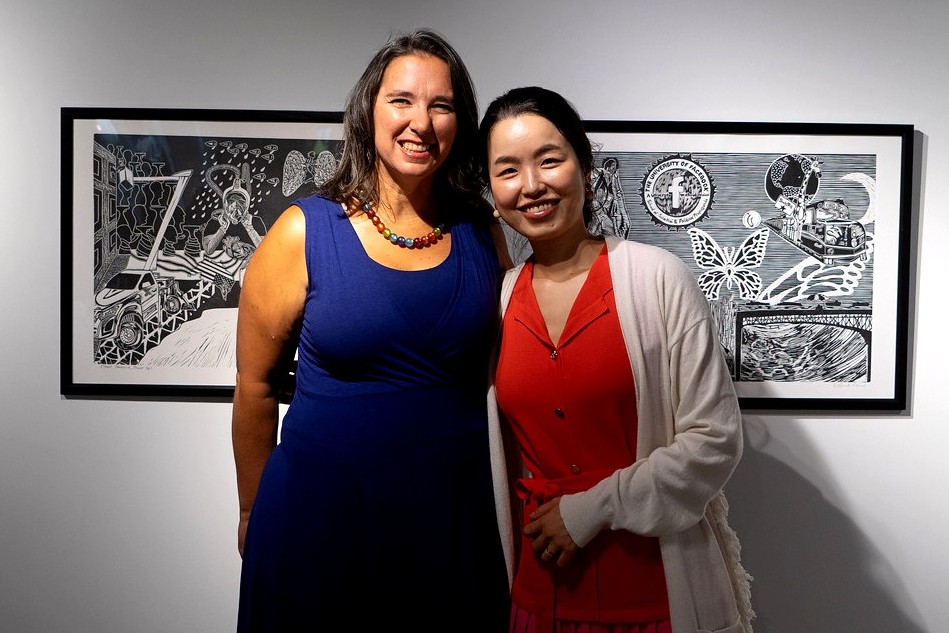
Now in its final year, the Creativity in the Time of COVID-19 project has amassed more than 2,000 pieces of art from all around the world showing all the diverse ways people, from all walks of life, turned to creativity during the pandemic. This artwork can now be viewed online in a global digital archive, and some of the pieces are now on display at Michigan State University in exhibitions at the Residential College in the Arts and Humanities LookOut Gallery through Monday, Oct. 14, and at (SCENE) Metrospace through Friday, Oct. 11.
The Creativity in the Time of COVID-19: Art as Medicine project is led by Natalie Phillips, Associate Professor in the Department of English and Founder and Co-Director of the Digital Humanities and Literary Cognition Lab at Michigan State University, Julian Chambliss, Professor in the Department of English and the Val Berryman Curator of History at the MSU Museum, and the entire team at the Digital Humanities and Literary Cognition Lab, which includes Soohyun Cho, who was a Postdoctoral Research Associate on the project and now is an Assistant Professor in the Center for Integrative Studies in the Arts and Humanities, and Tedda Hughes, who graduated from MSU with a Doctor of Law and serves as the Project Manager for the Creativity in the Time of COVID-19 project.
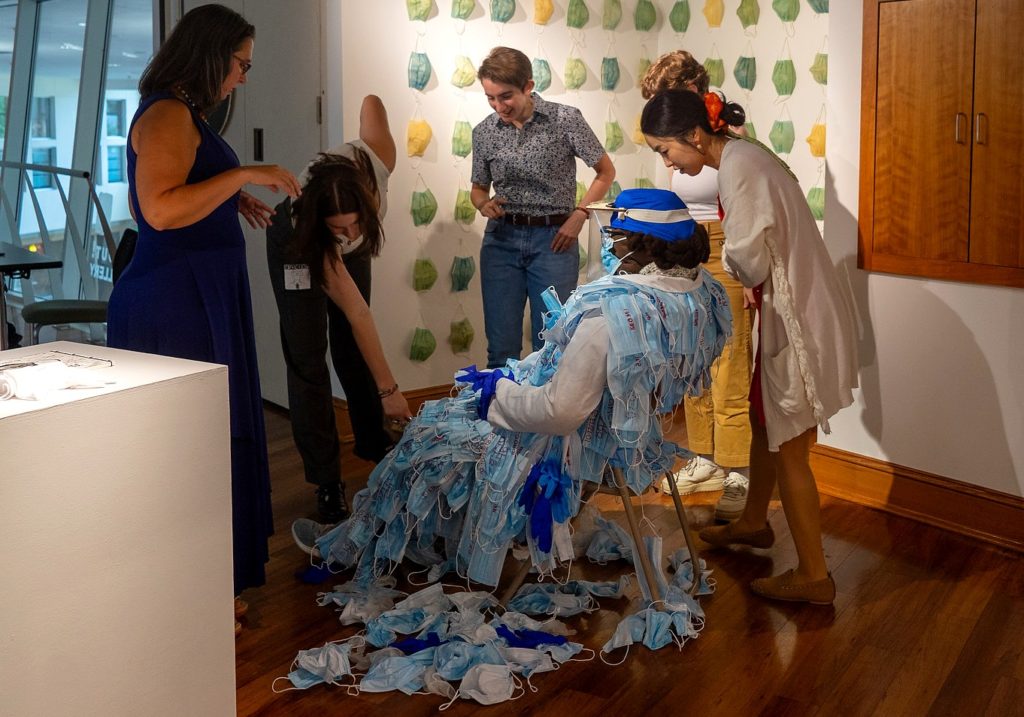
The exhibitions at Michigan State University are the culmination of the four-year, $3 million Mellon Foundation grant and the culmination of the satellite exhibitions that took place this past summer at Norwest Gallery of Art in Detroit, Michigan, and in Fall 2023 at the United States Air Force Academy in Colorado Springs, Colorado; Washington University in St. Louis, Missouri; and the Buffalo Arts Studio in Buffalo, New York, which was sponsored by the University of Buffalo. An exhibition also is planned for Oct. 23-Nov. 19, 2024, at Countway Library at Harvard University.
“This is what we hope will happen as people move through the exhibitions,” Phillips said, “not just that they will reflect on their own stories, which is crucial, but that it can take this vast landscape of grief and boredom and malaise and deep injustice around the pandemic and make it human in all its messy complexity and inspires us to move forward in whatever beautiful painful way we can.”
A two-day conference with the theme of “Art as Medicine” and the healing force of creativity also is planned for Thursday, Oct. 10, and Friday, Oct. 11, at the LookOut Gallery, which is located on the second floor of Snyder-Phillips Hall, and the Residential College in the Arts and Humanities (RCAH) Theatre, also located in Snyder-Phillips Hall. The conference also will focus on disability and access and how making spaces accessible for disability communities improves the experience for all.
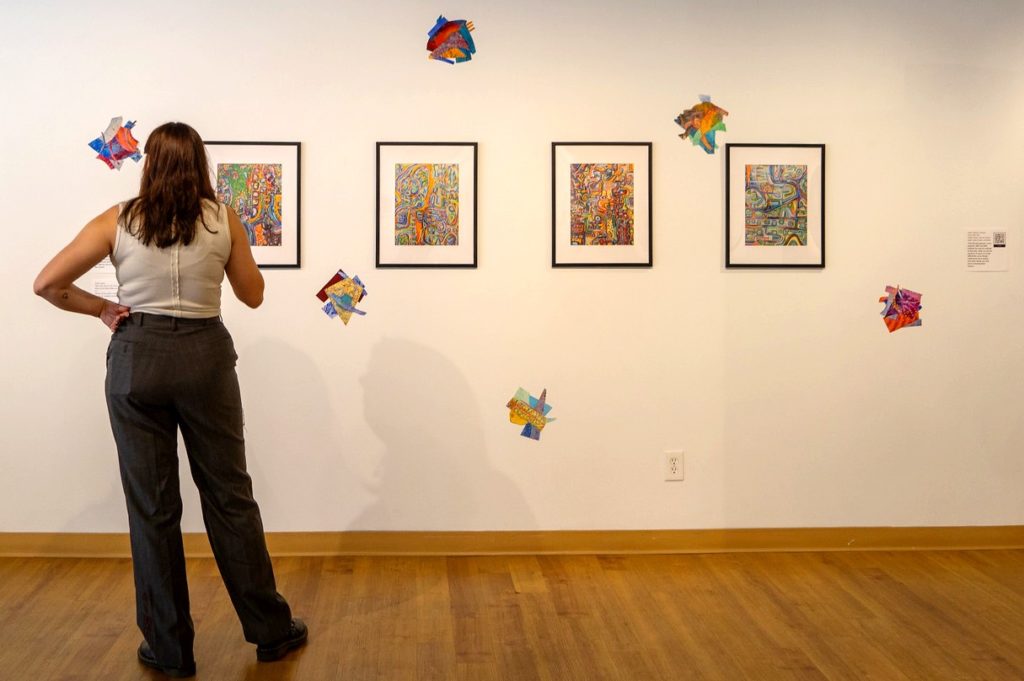
The conference will include exhibitions, interactive art, and speakers from across the country discussing topics including disability theory, COVID remembrance, arts in health, the power of creativity during times of crisis, and more.
The keynote speakers for the conference are:
Kleege’s talk, titled “Dancing with Statues: Touch and Movement in the Time of COVID,” will describe a number of projects, both before and after pandemic lockdowns, that were meant to advocate for multisensory and multimodal experiences in art museums to benefit blind and nonblind visitors alike. This talk is scheduled for Thursday, Oct. 10, at 6:30 p.m. in the RCAH Theatre.
Starr’s talk, titled “Loving the Beautiful: Why Beauty and the Arts Help Unlock Learning and Creativity,” will focus on cognitive science and educational value of the arts. It is about prioritizing the Humanities and Arts in a STEM-focused world.

There also will be panel discussions at the LookOut Gallery on “Disability and Access in the Time of COVID-19” on Thursday, Oct. 10, at 4:15 p.m. and on “Making & Mourning Through the Pandemic” on Friday, Oct. 11, at 4:15 p.m.
The MSU students who worked on this project and made it all possible will be in attendance and presenting at the conference. Also planning to attend the conference are a number of artists whose work is being shared as well as the heads of the satellite exhibitions at the U.S. Air Force Academy and the University of Buffalo.
For more information on the conference, including the schedule of events, visit the Art as Medicine: Creativity in the Time of COVID-19 conference eventbrite page.
When MSU students were asked to shelter in place in March 2020, Phillips encouraged her students to use creativity to process their emotions.
“When this whole project started, there was no idea of a Mellon grant, there was no idea of a grant at all. It started in a class of mine,” Phillips said. “It was March of 2020 and we’d all gone into lockdown and were all on zoom. The students in my class began sharing all the ways they were coping and how they were turning to these everyday acts of creativity.”
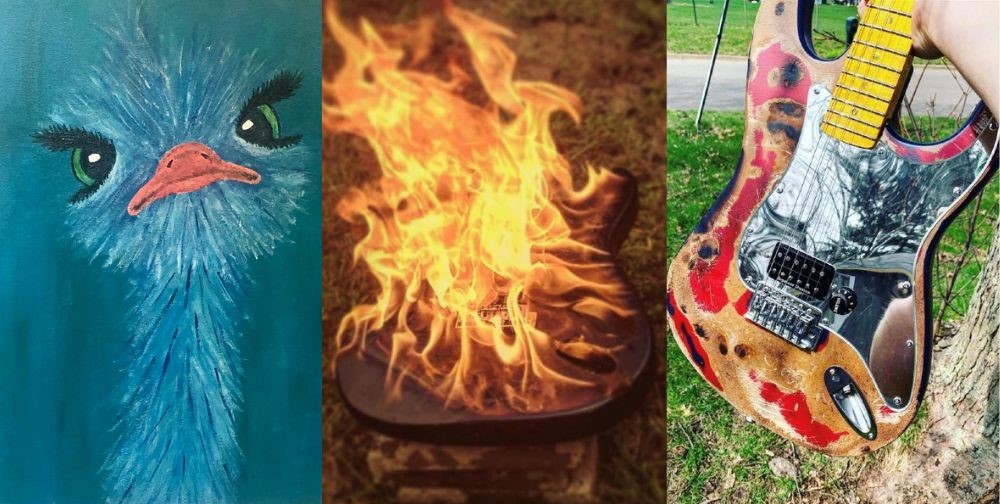
One of those students burned a guitar and rebuilt it to play his favorite death metal melody. Another student painting brightly colored ostriches to offset her whitewashed sanitized world. Others started crocheting and painting rocks.
“They were all turning to some form of art, and it was astonishing. It made me so excited to see art helping them get through this difficult time,” Phillips said. “I wondered if this was happening in a single class what was happening nationally, what was happening internationally?”
After observing her students and others using creativity to cope with the pandemic, Phillips conceived the Creativity in the Time of COVID-19 project with the goal of documenting the creative expressions and outlets used by those disproportionately impacted by the pandemic.
The project launched in January 2021 with the release of a detailed questionnaire seeking any form of creative expression that people turned to during the pandemic. The team received artworks from all across the United States and from Australia, Brazil, Canada, China, Colombia, Ecuador, France, India, Indonesia, Korea, Mexico, Portugal, Singapore, the United Kingdom, and Vietnam.
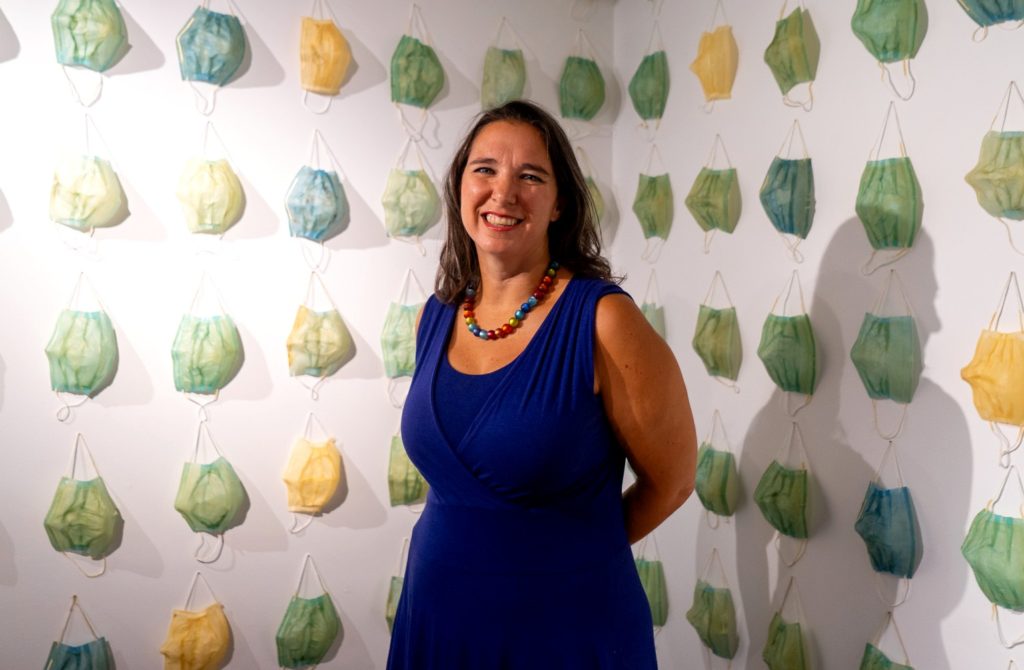
Once the creative pieces were collected, Chambliss worked with Agile Humanities to develop the website and online experience that complements the physical exhibitions so as to preserve this pandemic art digitally.
“This project has allowed us to think critically about how to best describe, display, and celebrate the diverse ways creativity emerged during the pandemic,” Chambliss said.
The stories behind this pandemic-inspired work also started to flow in. The art revealed stories of loss, anger, and sorrow, as well as stories of generosity, strength, and resilience, and of maintaining community and personal connections, during this global crisis. These stories also showed how artistic expression is a tool for combating inequity and injustice and the personal and systemic discrimination amplified by the pandemic.
“One of the goals of the project, and I think one of the hardest goals to try to actually achieve, is to think about how art making has the power to reveal and push back against the systemic inequities revealed by COVID,” Phillips said. “We sought to reach intersectional communities and amplify those voices including BiPOC, LGBTQIA+, Latinx, and Indigenous groups as well as neurodivergent and disability communities, among others, which I’m so proud and amazed to say are reflected in the exhibition.”
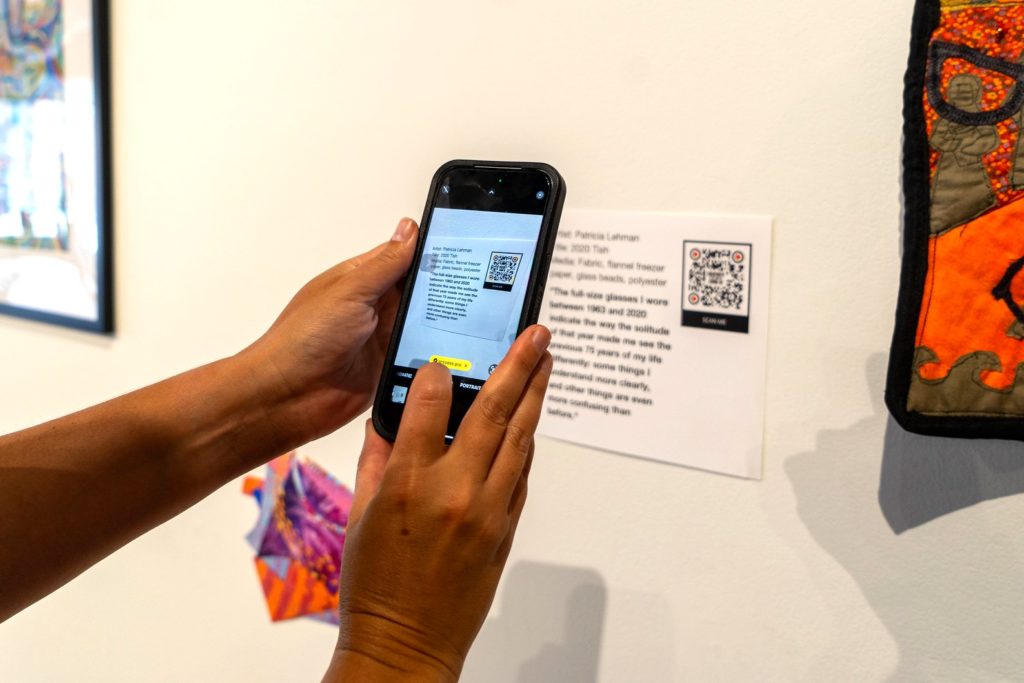
The exhibition at the LookOut Gallery includes about 130 art pieces from 30 artists and at (SCENE) Metrospace, which is located at 110 Charles Street in East Lansing, there are approximately 120 pieces from 26 artists on display. Each piece in these exhibitions has a QR code that links to the description of the piece in the digital archive and the audio narrative of the artist’s pandemic experience, which were all read by students in the Digital Humanities and Literary Cognition Lab.
“Each art piece is attached to a story of how that person used art to cope during COVID or turned to creativity as an act of protest, self-care, or resistance,” Phillips said. “You can find these actual stories by scanning the QR code by each artwork.”
The art pieces selected for these exhibitions highlight intersectional work from BiPOC, LGBTQIA+, and disability communities to call attention to the diverse roles art plays in expressing, processing, and healing trauma and to offer a way to see how art was used to cope, to understand, to forge new connections or hold onto existing ones, and to care for ourselves and our communities.
“This project is part of the unprecedented Just Futures initiative that supports multidisciplinary teams dedicated to work that revealed the ‘deep inequities and vulnerabilities…[for communities] disproportionately impacted by COVID-19,’” Phillips said. “Through the exhibitions and global archive, we asks audiences to enter into the myriad roles systemic injustice played in the pandemic and to appreciate the crucial role of art in transforming spaces of social justice.”
Much work also was done by the Creativity in the Time of COVID-19 team to integrate any access concerns from the outset in order to host events and create artifacts that are as accessible as possible.
“One of the core principles of our project is that accessibility is a process — part of production from the very start — and not just an end product to meet ADA compliance,” said Soohyun Cho, who co-curated the MSU exhibitions. “In our commitment to making this exhibition as accessible as possible, we offer multimodal access to artwork and stories, extending beyond the traditional modes of engagement. For instance, visitors are invited to explore the linoleum print artwork, titled COVID Chronicles, by Ellen Shattuck Pierce, in multiple ways: flipping through the original artbook, touching the tactile graphics version, and listening to audio recordings of image descriptions linked via QR code. At the heart of this practice is the inclusion of blind and low-vision individuals, as well as anyone who appreciates diverse aesthetic experience.”
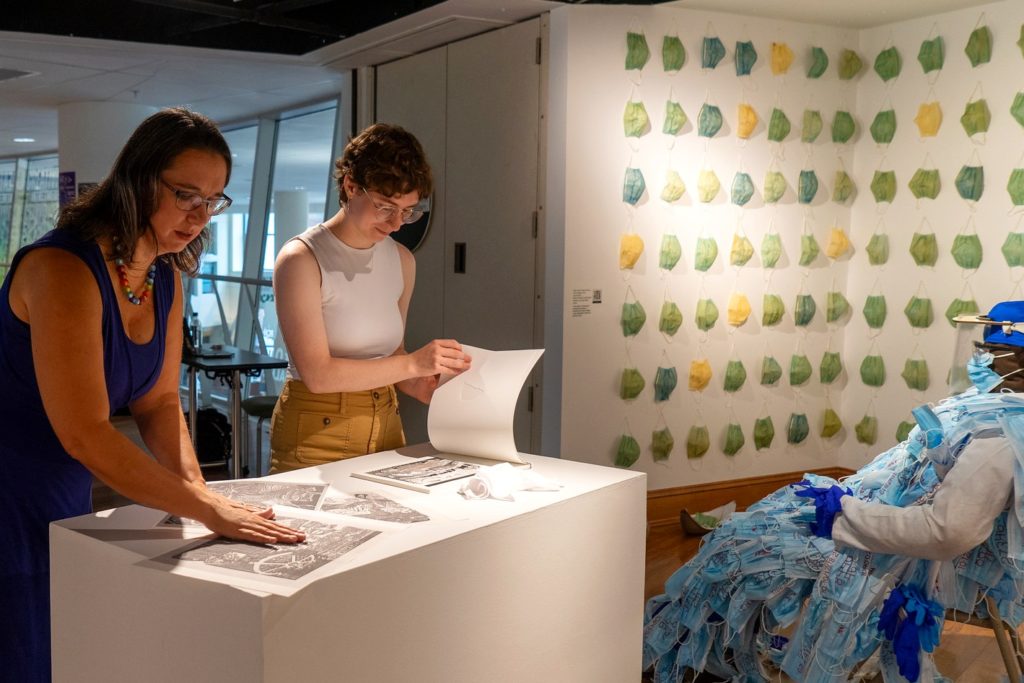
The Creativity in the Time of COVID-19 team worked with accessibility consultants — including HIVES, DisArt, and Clovernook — and a range of creators to adapt an inclusive experience within the global archive and the exhibitions. As an example of this work, each exhibition space has alternate sensory-hours and/or low-sensory spaces, videos are accompanied by audio descriptions, conference schedules include seated yoga, and select artworks have tactile versions created by the Clovernook Center for the Blind and Visually Impaired, a disability-run accessibility nonprofit.
“We hope to set a new standard for accessibility in museums, universities, and online resources,” Phillips said. “Throughout this project, we sought to foreground disability experience through a process centered around accessibility, in all its complexity. This emphasis on multimodal access to art is meant to challenge our traditional views of aesthetic experience, celebrating the diverse styles of engagement made possible by disability-centered practice for all.”
The Creativity in the Time of COVID-19 project involved a tremendous number of hours by many people. This dedicated team included graduate and undergraduate students, faculty, and staff of four different higher-ed institutions; consultants; and art gallery staff. It has given several MSU students the opportunity to be part of a large grant-supported interdisciplinary research project.

“Students have been entrusted with the important work of survey design, distribution (it was the undergrads in the lab who sent the thousands of emails to community leaders around the world!), and analysis in addition to developing exhibits based on our archive,” said Sydney Logsdon, an MSU senior with a double major in English and Environmental Studies and a minor in Global Studies in the Arts and Humanities, who also is the undergraduate lead for the Digital Humanities and Literary Cognition Lab (DHLC). “We aren’t just doing the tasks that someone assigns us; we’re managing entire projects and determining the future directions of the grant. All of us are learning as we go, providing support and guidance to one another as needed.
“Through this highly collaborative, socially conscious endeavor, I have gained so much perspective on life during COVID-19 beyond my experience of being stuck at home, and I have also grown into my interests as an interdisciplinary student and researcher. I’ve talked to the other undergraduates in the DHLC, and none of us fully knew how community-oriented and hands-on research could be — we all recognize that we have something really special going on with Creativity in the Time of COVID-19.”

The following is a list of all those who contributed to this project:
Michigan State University
MSU Graduate Researchers and Consultants
MSU Undergraduate Researchers
Consultants
Washington University in St. Louis
University of Buffalo
United States Air Force Academy
Detroit
East Lansing
San Francisco, Phoenix, and Boston
South Korea
In loving memory of Christopher Smit
By Kim Popiolek, originally published by the MSU College of Arts & Letters